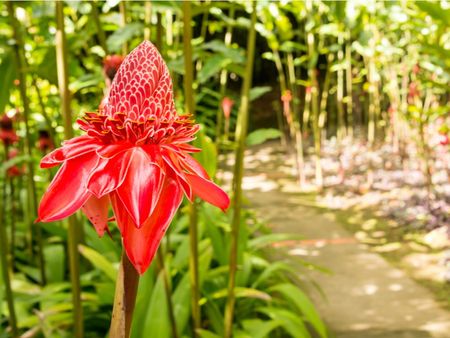Caring For Wild Ginger: How To Grow Wild Ginger Plants
Wild ginger is not related to culinary ginger, but is beautiful and fragrant in some humus-rich soil ina shady spot like a woodland garden.

Found throughout the world, but primarily in the shady woods of Asia and North America, wild ginger is a perennial not related to the culinary ginger, Zingiber officinale. There are a wide variety of species and cultivars to choose from, making the question, “Can you grow ginger plants in the wild?” an easy and emphatic “yes.”
Ginger Plants in the Wild Backyard Garden
Wild ginger plants (Asarum and Hexastylis species) are 6 to 10 inches (15-25 cm.) tall with a spreading habit of 12 to 24 inches (31-61 cm.), depending on the variety.
Wild ginger plants tend to grow moderately slowly and are non-invasive with evergreen, kidney-shaped or heart-shaped leaves.
Versatile and easily grown, growing wild ginger is an excellent choice in a woodland garden, as a shade ground cover or mass plantings.
Ginger plants in the wild have interesting, although not particularly lovely, spring blooms (April through May) that are hidden at the base of the plant among the stems. These flowers are about an inch (2.5 cm.) long, shaped like an urn, and are pollinated by ground insects such as ants.
Is Wild Ginger Edible?
Although not the same as culinary ginger, most wild ginger plants can be eaten, and as their common name suggests, have a similar spicy, ginger-like aroma.
The fleshy root (rhizome) and leaves of most wild ginger plants can be substituted in many Asian cuisines, however, some forms of wild ginger have an emetic property, so care should be taken when selecting and ingesting.
Gardening tips, videos, info and more delivered right to your inbox!
Sign up for the Gardening Know How newsletter today and receive a free copy of our e-book "How to Grow Delicious Tomatoes".
Caring for Wild Ginger
Caring for wild ginger requires full to partial shade, as the plant will burn in full sun.
Wild ginger prefers acidic, humus-rich, well-drained yet moist soil for lush plants.
Ginger plants in the wild spread via rhizomes and can be easily divided in the early spring by slicing through the surface growing rhizomes. Wild ginger may also be propagated by seed, although patience is definitely a virtue here, as the wild ginger plant takes two years to germinate!
Grow wild ginger plant under trees and in front of taller plants in shaded areas to create a low maintenance, naturalistic landscape.
One issue that might arise from these generally moist areas of the garden is damage to plants as the result of snails or slugs, especially in the early spring. The signs of damage on wild ginger plants will be big, irregular holes in foliage and slimy mucus trails. To battle against this prominent damage, remove mulch and leaf detritus near the plants and spread diatomaceous earth around the plants. If you aren't squeamish, look for slugs a few hours after dark using a flashlight and remove them by hand picking or create a trap of shallow, beer-filled containers placed in a hole in the soil with the rim level to the soil.
Varieties of Wild Ginger Plant
Native to eastern North America, the Canadian wild ginger is an example of a wild ginger variety that has historically been eaten. Early settlers used this Asarum canadense fresh or dried as a substitute for culinary ginger, although they were probably ingesting it more for its medicinal uses rather than in a gingered chicken stir fry.
The roots of this plant were eaten fresh, dried, or candied as an expectorant and were even used as a contraceptive tea by Native Americans. Caution should be taken with this wild ginger however, as it may cause skin rashes in some people. Just as the Canadian wild ginger may cause skin rashes, the European ginger (Asarum europeaum) acts as an emetic, so its ingestion should be avoided altogether.
This European native is an attractive evergreen species which, as well as the Canadian species, is hardy in USDA zones 4 through 7 or 8. A variegated variety, the Mottled wild ginger (Asarum shuttleworthii) is a less hardy (zones 5 to 8) plant native to Virginia and Georgia. This wild ginger and some other species are now in the genus Hexastylis, which include ‘Callaway,' a slow, matted ginger with mottled foliage and ‘Eco Medallion,' a silver-leaved compact wild ginger plant.
Also counted among this genus are larger types ‘Eco Choice' and ‘Eco Red Giant.'

Amy Grant has been gardening for 30 years and writing for 15. A professional chef and caterer, Amy's area of expertise is culinary gardening.
-
 New England April Garden Checklist: What Flowers, Shrubs, Veggies & Herbs To Plant Now
New England April Garden Checklist: What Flowers, Shrubs, Veggies & Herbs To Plant NowLearn what crops and ornamentals to plant in April for a thriving garden in Connecticut, Maine, Massachusetts, New Hampshire, Rhode Island, or Vermont.
By Ellen Wells
-
 5 Fabulous Fast-Growing Vines – That Will Quickly Climb Any Arbor, Trellis, Or Fence
5 Fabulous Fast-Growing Vines – That Will Quickly Climb Any Arbor, Trellis, Or FenceThese fast growing vines are perfect for covering any eyesores in your yard or creating a living fence. They will provide great visual interest, as well.
By Amy Grant
-
 Peacock Ginger Plant Care: Learn How To Grow Peacock Ginger Plants
Peacock Ginger Plant Care: Learn How To Grow Peacock Ginger PlantsIn warmer climates, growing peacock ginger is a great way to cover a shady part of the garden. This pretty groundcover thrives in the shade and produces distinctive, striped leaves along with small, delicate flowers. Learn more about the plant in this article.
By Mary Ellen Ellis
-
 Ginger Insect Problems – Tips On How To Manage Ginger Pests
Ginger Insect Problems – Tips On How To Manage Ginger PestsGrowing ginger in your backyard garden is easy. That is, it's easy until the pests swoop in and start devastating your plants. Ginger insect problems are manageable, but you need to know what pests may attack and how to deal with them. This article will help.
By Mary Ellen Ellis
-
 Ornamental Ginger Plants - A Guide To Flowering Ginger Varieties
Ornamental Ginger Plants - A Guide To Flowering Ginger VarietiesOrnamental ginger plants can be a great way to add attractive and exotic color, foliage, and blooms to your garden. Whether they go in beds or in containers, these plants offer diversity without a lot of maintenance. Learn more about them in this article.
By Mary Ellen Ellis
-
 Hedychium Ginger Lily Info: Tips On Caring For Butterfly Ginger Lilies
Hedychium Ginger Lily Info: Tips On Caring For Butterfly Ginger LiliesHedychium is often called butterfly ginger lily or garland lily. Each species has a unique floral shape but characteristic "canna-like" large foliage. Learn more about this plant and how to grow it in the article that follows.
By Bonnie L. Grant
-
 Panda Face Ginger Info: Tips For Growing Panda Face Ginger Plant
Panda Face Ginger Info: Tips For Growing Panda Face Ginger PlantIf you are looking for a shade-loving plant to fill a gap in the landscape, you might want to try a wild ginger. One of the more spectacular specimens is Asarum maximum, or Panda Face ginger. Learn how to grow it in this article.
By Amy Grant
-
 Beehive Ginger Care: Learn How To Grow Beehive Ginger
Beehive Ginger Care: Learn How To Grow Beehive GingerThe beehive ginger plant is of tropical origin, so if you are more north of the equator, you may wonder if it is possible to grow and, if so, how to grow beehive ginger in your garden. This article will help with that.
By Amy Grant
-
 Torch Ginger Flowers: How To Grow Torch Ginger Lilies
Torch Ginger Flowers: How To Grow Torch Ginger LiliesThe torch ginger lily is a showy addition to the tropical landscape. Find out how to grow this interesting plant by reading the following article. Click here to get more information.
By Becca Badgett
